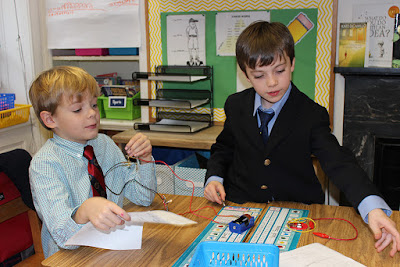Second graders are discovering how electrical circuits and switches work by making their own.
In a recent class, the boys, after learning that some materials allow electrical flow while others do not (conductors and insulators), put their knowledge to task: they had to build their own switch.
Their switches had to contain a moving part and, when activated, had to either make electricity flow or not flow. The boys got to work, experimenting with materials including aluminum foil, clay, paper clips, and pop sticks.
They quickly found that the challenge could be a bit tricky, but were all the more intrigued when their designs didn't work and were eager and determined to find the right combination of materials that would lead to a successful electrical switch!
Trial and error, learning through multiple attempts, observing the efforts of others in the class--all of these strategies help to develop our boys' curiosity and ability to solve problems creatively.
Their switches had to contain a moving part and, when activated, had to either make electricity flow or not flow. The boys got to work, experimenting with materials including aluminum foil, clay, paper clips, and pop sticks.
They quickly found that the challenge could be a bit tricky, but were all the more intrigued when their designs didn't work and were eager and determined to find the right combination of materials that would lead to a successful electrical switch!
Trial and error, learning through multiple attempts, observing the efforts of others in the class--all of these strategies help to develop our boys' curiosity and ability to solve problems creatively.




Comments
Post a Comment